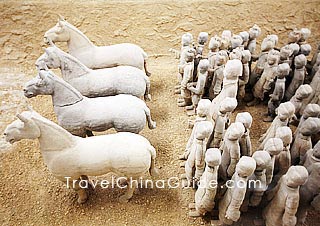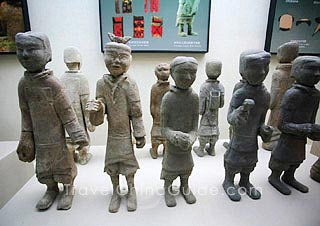Xuzhou Museum of Terra-cotta Warriors and Horses of Han Dynasty
 |
Warriors and Horses of Han Dynasty |
Lying at the foot of Lion Mountain, the museum covers over 6,000 square meters (1.48 acres). It is an important part of the tomb of Liuwu, who was the third king of the Chu Kingdom in the Western Han Dynasty (206BC-24AD). The funerary objects of the king, about 4,800 pieces of colored terracotta warriors and horses about 40 cm (15.7 inches) filled with vivid expressions, have been unearthed.
There are six pits altogether in the T erracotta Warriors and Horses of the Han Dynasty: three infantry pits, one pottery-guard pit, one cavalry pit and one chariot pit. So far only two infantry pits and one pottery-guard pit have been excavated fully. In the two infantry pits there are about 1,016 pottery figures in Pit No.1 and 1,377 in Pit No.2. The terracotta
 |
| Terracotta Warriors of the Han Dynasty |
Apart from the six pits, there is a military exhibition hall and a temporary exhibition hall added to the museum after its extension in 2005. In the military exhibition hall you can see some weapons from the Han Dynasty and the battle array of the terracotta warriors and horses. The temporary exhibition hall is being prepared for cultural relics on loan from other museums.
Compared with the Xi'an Terracotta Warriors and Horses of the Qin Dynasty, the Han tomb figures are smaller but the development of their features is based on that in the Qin Dynasty. In the Han Dynasty, craftsmen paid careful attention to detail. They focused on the soldiers' inner world and their spirit. As tomb figures of the king, most of them show some sorrowful and respectful expressions. According to historical records, citizens between 18 and 55 years old in the Han Dynasty had to join the army for two years. Consequently you can see both young and old soldiers among the pottery figures.
| Admission Fee: | CNY 90 (including Tomb of the Chu King (Liu Wu), Zhulin Temple, Gallery of Han Stone Sculptures and Museum of Han Terra-cottta Warriors and Horses) |
| Bus Route: | take bus no. 5, 49, 60, 65, 71, 72, 92, 93, 97, 605, 608 or 611 and get off at Chuwangling Station |
- Last updated on Jun. 21, 2022 -